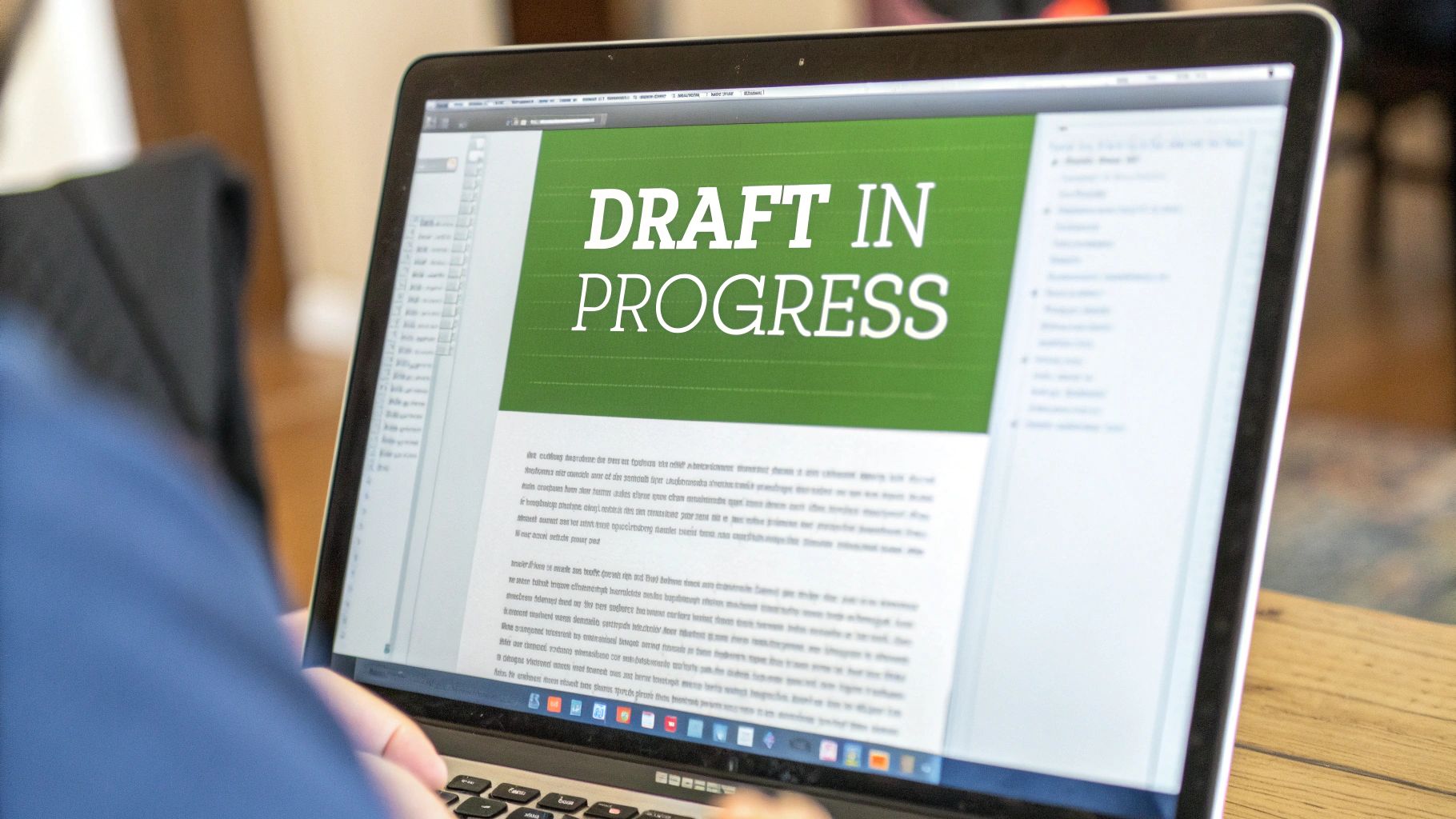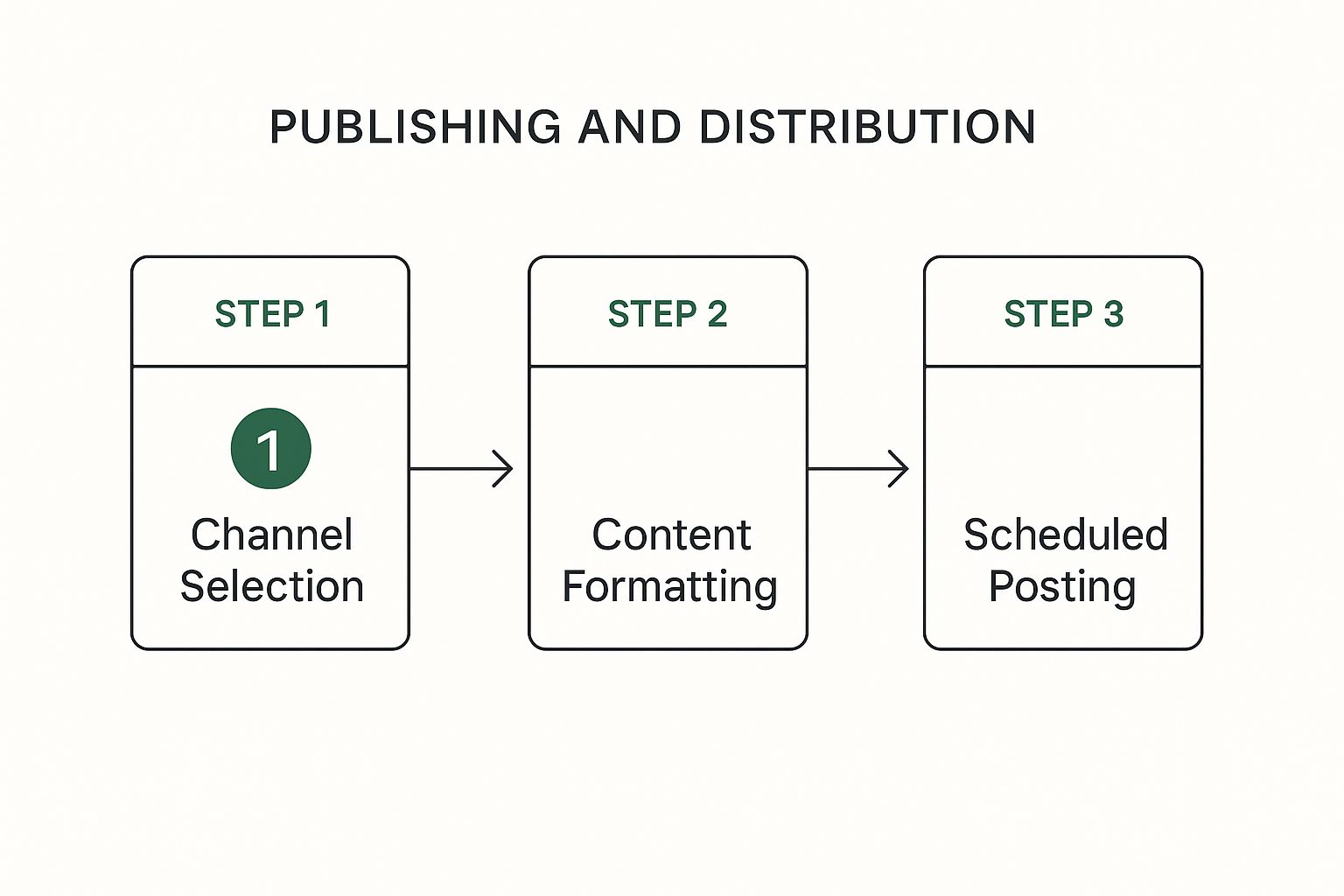
Build a Better Content Creation Workflow
July 6, 2025
If you're still using a sloppy, "just get it done" approach for your content, you’re not just being inefficient—you're actively losing money. A solid content creation workflow is the engine that turns your ideas into published assets. Without one, you're just spinning your wheels.
Why Your Current Content Process Is Costing You

Let's be real for a second. That unstructured, fly-by-the-seat-of-your-pants content process is holding your team back. It probably feels like you're constantly putting out fires instead of building a reliable system for growth. That kind of chaos isn't just stressful; it has real, tangible consequences for your business.
The Real Price of Disorganization
When there's no clear process, familiar pain points start popping up, and they hit you right in the bottom line. You see inconsistent quality because there are no standardized checks. Team members get burned out trying to navigate a maze of confusing handoffs and vague feedback.
This disorganization creates predictable problems:
- Missed Deadlines: Projects fall behind without clear stages and timelines, throwing your entire content calendar into disarray.
- Wasted Resources: Time gets torched on endless revisions, hunting for files, or redoing work that wasn't briefed properly in the first place.
- Bottlenecks and Blockers: One person's delay grinds the whole production line to a halt. It’s impossible to scale your output this way.
A haphazard content creation workflow doesn't just slow you down; it prevents you from building momentum. It turns content from a strategic asset into a series of unpredictable, one-off tasks.
Sound familiar? Sometimes the problems are so ingrained in our day-to-day that it's hard to see them clearly. This table breaks down common symptoms of a broken workflow and connects them to the root cause.
Signs Your Content Creation Workflow Is Broken
| Symptom | Potential Cause in Your Workflow | Long-Term Impact |
|---|---|---|
| Constant "Urgent" Revisions | Lack of a clear creative brief or sign-off stage. | Team burnout and eroded creative quality. |
| Inconsistent Brand Voice | No standardized style guide or quality assurance (QA) step. | Diluted brand identity and confused audience. |
| Files Are Always "Lost" | No centralized asset management system. | Wasted hours searching for assets and potential legal risks. |
| Deadlines Are Always Slipping | Absence of defined stages, owners, and timelines. | Unreliable publishing schedule and missed market opportunities. |
| Team Members Are Confused | Vague roles and responsibilities; poor communication channels. | Low morale, duplicated work, and high employee turnover. |
Recognizing these signs is the first step. The goal isn't just to patch holes but to build a system that prevents them from appearing in the first place.
The Shifting Demands of Content Creation
The need for a rock-solid workflow has become even more urgent as content creation has shifted from a side hustle to a full-blown profession. A 2021 survey really drove this home, finding that while 36% of creators spent 1 to 5 hours a week on content, a serious 14% dedicated over 20 hours—with some putting in more than a full-time workweek. You can dive deeper into these trends in a recent digital content creation statistics report.
Ultimately, a structured content creation workflow isn't about being tidy for the sake of it. It's about building a predictable, scalable system that delivers consistent quality, empowers your team, and turns your creative efforts into a reliable source of business growth.
Turning Ideas Into a Strategic Content Pipeline
Great content rarely comes from a random spark of genius. It’s born from a system. If you want to move past chaotic brainstorming sessions that go nowhere, you need a reliable pipeline for generating, vetting, and prioritizing ideas that actually help your business. This is where your content creation workflow truly starts to take shape.
The whole process kicks off when you build a centralized idea bank. And I don't mean a messy, forgotten document. This should be a structured repository—something like a Trello board, an Asana project, or even a well-organized spreadsheet. This is the place to capture everything: random shower thoughts, customer questions you overheard from the sales team, and even interesting angles your competitors are taking.
With so many people creating content these days, you can't afford to be inefficient. The creator economy has exploded, with over 165 million new creators joining social media platforms since 2020. Since six out of ten creators are also juggling full-time jobs, smart planning is the only way to stay balanced and avoid burnout. You can dig into more of these fascinating creator economy statistics if you're curious.
Vetting Ideas With Purpose
Once your idea bank starts filling up, the real work begins: strategic vetting. Let's be honest, not every idea deserves to become a full-blown article or video. You have to filter them through a lens of potential impact, shifting from a "what if" mindset to a much more practical "what for" approach.
For every potential topic, you should be asking some tough questions:
- Audience Alignment: Does this actually solve a known problem or answer a real question our target audience has?
- Business Goal: Is the point of this piece to boost SEO, generate leads, build our brand authority, or nurture existing customers? Get specific.
- Competitive Angle: Can we genuinely create something 10x better than what's already ranking for this topic? What unique perspective can we bring to the table that no one else has?
This evaluation process is what helps you separate the nice-to-haves from the must-haves. It ensures you're putting your time and money into content that has the highest chance of paying off.
An idea is just a starting point. A strategic pipeline transforms that starting point into a predictable asset by validating its purpose before a single word is written.
From Idea to Actionable Brief
The final step in this early stage is turning a winning idea into a crystal-clear content brief. This document is the blueprint for your writers and creators. It’s designed to eliminate guesswork and make sure the final piece aligns perfectly with your strategic goals.
A solid brief is the bedrock of an efficient content creation workflow. It should always include:
- Primary and Secondary Keywords: The exact search terms you're aiming for.
- Target Audience Persona: A quick snapshot of who you're writing for.
- Key Talking Points: The non-negotiable arguments or pieces of information that must be included.
- Competitor Links: A few examples of top-ranking content to analyze and, more importantly, improve upon.
- Call to Action (CTA): What do you want the reader to do when they're done?
By putting in the effort on the front end, you give your team the clarity they need to knock it out of the park. This simple step drastically cuts down on endless revision cycles and guarantees every piece of content is strategically sound right from the get-go.
Crafting and Refining Content Without the Chaos

Alright, your strategic brief is locked in. Now comes the part where ideas turn into actual, tangible content. This is also where things can get messy—fast.
Without a clear system, the production phase quickly becomes a chaotic scramble of missed deadlines, conflicting edits, and general confusion. I’ve seen it happen too many times.
The secret to keeping things smooth is assigning crystal-clear roles before anyone writes a single word. This isn’t about micromanaging. It's about creating a predictable relay race where the writer, editor, designer, and SEO specialist know exactly when to grab the baton. When a writer finishes a draft, it shouldn't just sit there. It should automatically trigger a handoff to the editor, who then passes it to the next expert in line.
Building a Constructive Feedback Loop
Good feedback is the lifeblood of great content, but it needs structure. When feedback flies in from every direction at random times, you end up in "edit hell." It’s that painful place where a piece gets revised so many times that it loses its soul.
To sidestep that nightmare, set up a formal review cycle with a few ground rules:
- One Place for All Notes: Have everyone leave their feedback in a single, centralized document. Google Docs comments are perfect for this. It stops writers from getting conflicting advice from three different people.
- Set a Revision Limit: Be firm about how many rounds of edits you’ll do. I find two rounds is the sweet spot: one for big, structural changes and a final one for minor polishing.
- Feedback by Expertise: Encourage people to stay in their lane. The designer should focus on visuals and layout, while the SEO specialist should be checking keywords and on-page elements.
A well-managed feedback process doesn’t stifle creativity; it channels it. Every revision should add real value and push the content closer to the finish line, not send it back to the drawing board.
Using Checklists for Quality Assurance
Before you even think about hitting publish, a final quality assurance (QA) check is non-negotiable. The simplest way to do this is with a checklist. It’s a powerful tool that turns a subjective once-over into an objective, repeatable process. This is the final checkpoint in your content creation workflow.
Your checklist will be unique to your brand, but it should cover the basics.
- Brand Voice: Does this sound like us? Is the tone right?
- SEO Elements: Are the primary keyword, meta description, and alt text all in place?
- Readability: Are the paragraphs short and scannable? We have a whole guide on how to write compelling content that digs deeper into this.
- Links: Do all the links actually work? Do they open in a new tab?
- Visuals: Are the images high-quality, properly credited, and optimized for the web?
With a system like this, your production phase becomes predictable. Everyone knows what they’re doing, feedback is actually helpful, and every piece of content meets your quality standard before it ever sees the light of day.
Maximizing Reach with Smart Distribution
Hitting "publish" on a piece of content feels great, but it's a milestone, not the finish line. In a really well-run content creation workflow, the moment a post goes live is just the beginning of its next, equally important phase: distribution.
Without a smart plan to get it in front of people, even the most brilliant article can sit there unseen. All that hard work? Invisible.
The Final On-Page SEO Check
Before you even think about sharing, you need to do one last on-page SEO check. This isn't just a technicality to tick off a list; it's about giving your content the best possible chance to be found by search engines right from the start.
Make sure every piece is perfectly in place before you start promoting.
Your Pre-Distribution SEO Checklist
This quick pass ensures your content is primed for discovery.
- Metadata Mastery: Is your meta title and description compelling? Do they include your main keyword? This is your content's first handshake with someone on a search results page.
- Strategic Internal Links: Have you linked to other relevant posts on your own site? This is huge. It helps search engines understand what your content is about and keeps your readers clicking around.
- Optimized Visuals: Does every single image have descriptive alt text? This is a must for both accessibility and ranking in image searches.
Once you’ve got these fundamentals locked down, you’re ready to start pushing your content out into the world.
Building a Multi-Channel Distribution Plan
Here’s where so many people go wrong. They drop a link on their social channels and call it a day. That’s not a strategy. A truly effective distribution plan is all about intelligent repurposing and targeted outreach.
Your goal should be to turn one big piece of content into a dozen little pieces of micro-content, each one shaped for a different platform.
Hitting 'publish' gives your content a home. Strategic distribution gives it a megaphone, ensuring it reaches every corner of your audience's digital world.
Let’s say you just published a detailed blog post. That single asset can be sliced and diced into so much more:
- A Twitter Thread: Pull out the key takeaways and turn them into a series of punchy, engaging tweets.
- An Instagram Carousel: Design a few visually slick slides that summarize the main points for a more visual audience.
- A LinkedIn Article: Give it a professional spin. Adapt the tone to focus on the business implications or career advice. You can find more professional writing tips that will help you nail the tone for different platforms.
- Email Newsletter Content: Don't just send the link. Tease an exclusive insight from the post to your subscribers, making them want to click back to your site for the full story.
- Community Posts: Find relevant subreddits or Facebook groups where your content can actually solve a problem or add real value to a conversation already happening.
The trick is to create a distribution checklist that becomes a non-negotiable part of every project. This bakes this vital step right into your content creation workflow, so it never becomes an afterthought. When you're this deliberate about how and where you share your work, you don't just get more views—you get more impact.
How to Automate and Scale Your Content Engine
A manual content creation workflow can only take you so far. To really grow, you need to build an engine—a system that runs with less hands-on effort and frees up your team to do the high-impact creative work they were hired for. This is where smart automation and scaling come in.
The idea isn’t to replace your creators. It's about empowering them by getting rid of the repetitive, low-value tasks that clog up their day. Project management tools like Asana or Trello are the perfect place to start. You can build out templates that automatically assign tasks for each stage—from drafting to design—which then trigger notifications and update statuses as content moves through the pipeline.
This kind of structure means handoffs are seamless. Everyone has clarity on what they need to do without another meeting or a dozen follow-up emails.
Integrating AI as a Creative Partner
Artificial intelligence is a huge ally in scaling your workflow. Instead of seeing it as a replacement for writers, think of it as a super-efficient research assistant or data analyst. This isn't some futuristic idea; it's already happening.
The shift is real. Today, one in two writers use AI to boost their content's performance. This trend is backed by serious investment, too. Looking ahead to 2025, 11.4% of marketers plan to spend over $45,000 per month on content, a clear signal that automation-heavy strategies are the future. You can dig deeper into these content marketing statistics and trends to get the full picture.
So, how can you bring AI into the fold ethically and practically?
- Speed Up SEO Research: Use AI to analyze keyword clusters and pinpoint content gaps faster than any human possibly could.
- Generate First-Draft Outlines: Give AI your brief and ask for a structured outline. This gives your writers a solid framework to build on, not a blank page.
- Analyze Content Performance: Feed your performance data into an AI tool to spot trends and get smart recommendations for future topics or content refreshes.
By handing over these data-heavy tasks, you let your team focus their energy on what they do best: strategy, storytelling, and creating exceptional content that technology simply can't replicate.
Visualizing Your Publishing Process
To scale well, every single stage of your content workflow needs to be crystal clear, especially the final steps of publishing and distribution. This simple flow chart breaks down the core parts of getting your content out the door and in front of your audience.

This visual makes one thing obvious: publishing isn’t just a single click. It's a sequence of deliberate choices, from picking the right channels and formatting content for each one, to scheduling it for maximum impact.
Building a scalable content engine means creating a resilient system that grows with you. It’s about leveraging technology to handle the grunt work so your people can do what they do best: create.
The result is a workflow that doesn't just produce more content; it produces better content, more efficiently. It frees you from the daily grind and lets you focus on the bigger picture—turning your content operation into a predictable, powerful engine for business growth.
Answering Common Questions About Content Workflows

Even with the best-laid plans, practical questions always come up. As you start to build or fine-tune your content creation workflow, you’re bound to hit a few hurdles or wonder about some "what if" scenarios. It's completely normal.
Here are some straightforward answers to the most common questions we hear from teams getting their systems in order.
What Are The Best Free Tools To Start Building A Workflow?
You absolutely don't need a massive budget to get organized. In my experience, a smart combination of free tools can build an incredibly powerful foundation for your entire process.
For a content calendar and idea bank, you can't go wrong with Google Sheets or the free plan from Airtable. To actually see your process in motion, Trello's free tier is fantastic. Its Kanban-style board lets you drag a card from the "Idea" column all the way to "Published." It’s simple and visual.
When it's time to write, Google Docs is still the undisputed champ for collaborative writing and editing. Pair that with Google's own Keyword Planner for some basic SEO research, and you've got a robust, no-cost system to manage your entire content creation workflow.
The goal is to start simple. Choose tools that reduce friction, not add complexity. You can always upgrade later as your team and needs grow, but a solid, simple foundation is the most important first step.
How Do I Get My Team To Actually Follow The New Workflow?
This is the big one. A workflow is completely useless if nobody follows it. The secret isn't about enforcing rules; it’s about creating a system that genuinely makes everyone's job easier.
Start by involving your team in the creation process itself. When people have a hand in building the system, they feel a sense of ownership and are way more likely to adopt it. Once it's built, document everything clearly. A short video walkthrough or a simple one-page guide explaining each step, the tools, and who is responsible for what can be a game-changer.
Finally, you have to lead by example. Use the workflow for your own tasks and gently guide people back to it when they stray. Frame it as a system designed to kill confusion and lower stress, not a set of restrictive new rules.
How Often Should I Review And Update The Workflow?
Your workflow needs to be a living system, not a static document you set in stone. Your business will change, your team will evolve, and new tools will pop up. A great habit is to schedule a quarterly review with everyone involved.
During this check-in, focus the conversation on a few key areas:
- Bottlenecks: Where is work getting stuck? What's causing the delays?
- Redundancies: Are there any steps that are now unnecessary or could be combined?
- Opportunities: Is there a new piece of tech or a different process that could make a stage more efficient?
For instance, maybe your team is spending way too much time on basic draft revisions. That's a perfect opportunity to explore new tools or refine your briefs to improve first-draft quality. You can find more ideas by exploring some effective writing strategies that focus on clarity from the start. Regular reviews ensure your content creation workflow remains a powerful asset, not an outdated relic.
What Key Metrics Should I Track To Measure Success?
To know if your workflow is really working, you need to look past standard content metrics like page views. It’s just as important to track production metrics that directly reflect the efficiency of your process.
Focus on tracking data points like these:
- Time to Completion: The average time it takes for a piece to go from an approved idea to live on the site.
- Revision Rounds: The average number of editing cycles a piece of content needs before it gets the final sign-off.
- On-time Delivery Rate: The percentage of content that gets published on its originally scheduled date.
If your "Time to Completion" is dropping while your "On-time Delivery Rate" is climbing, you have clear proof that your new workflow is doing its job.
Ready to make your writing sound more human and less like AI? Natural Write instantly refines robotic text, ensuring your content is clear, engaging, and bypasses AI detection with a single click. Try it for free and see the difference at https://naturalwrite.com.


